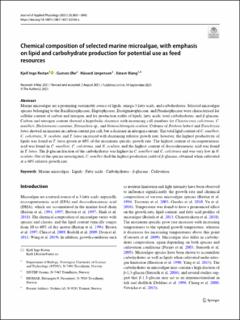Chemical composition of selected marine microalgae, with emphasis on lipid and carbohydrate production for potential use as feed resources
Peer reviewed, Journal article
Published version
Permanent lenke
https://hdl.handle.net/11250/2999805Utgivelsesdato
2021Metadata
Vis full innførselSamlinger
- Publikasjoner fra CRIStin - SINTEF Ocean [1403]
- SINTEF Ocean [1478]
Sammendrag
Marine microalgae are a promising sustainable source of lipids, omega-3 fatty acids, and carbohydrates. Selected microalgae species belonging to the Bacillariophyceae, Haptophyceae, Eustigmatophyceae, and Prasinophyceae were characterised for cellular content of carbon and nitrogen, and for production yields of lipids, fatty acids, total carbohydrates, and β-glucans. Carbon and nitrogen content showed a hyperbolic decrease with increasing cell numbers for Chaetoceros calcitrans, C. muelleri, Skeletonema costatum, Tetraselmis sp., and Nannochloropsis oculata. Cultures of Pavlova lutheri and Tisochrysis lutea showed an increase in carbon content per cell, but a decrease in nitrogen content. The total lipid content of C. muelleri, C. calcitrans, N. oculata, and T. lutea increased with decreasing relative growth rate; however, the highest productivity of lipids was found in T. lutea grown at 40% of the maximum specific growth rate. The highest content of eicosapentaenoic acid was found in C. muelleri, C. calcitrans, and N. oculata, and the highest content of docosahexaenoic acid was found in T. lutea. The β-glucan fraction of the carbohydrates was highest in C. muelleri and C. calcitrans and was very low in N. oculata. Out of the species investigated, C. muelleri had the highest production yield of β-glucans, obtained when cultivated at a 40% relative growth rate.

